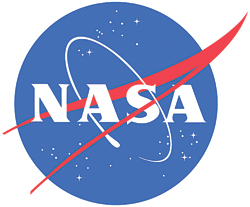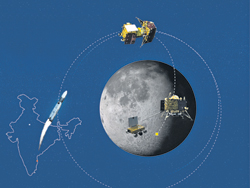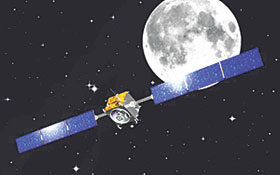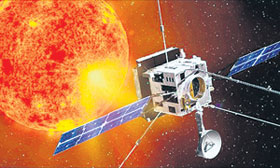August 2019 Science and Technology
Sakshi Education

- NASA investigating first crime committed in space
The US space agency NASA is reported to be investigating a claim that an astronaut accessed the bank account of her estranged spouse from the International Space Station.
This is the first such allegation of a crime committed in space.
US media report that Astronaut Anne McClain is accused of identity theft and improperly accessing her estranged spouse's private financial records while on a sixth-month mission aboard the International Space Station.
The astronaut's spouse Summer Worden filed a complaint earlier this year with the Federal Trade Commission after learning McClain had accessed her bank account without permission, while Worden's family filed another with NASA's Office of Inspector General.
The astronaut had done nothing wrong and accessed the bank records while to monitor the couple's combined finances something she had done over the course of their relationship.
- North Korea fires two short-range ballistic missiles into sea off its east coast
North Korea has fired two short-range ballistic missiles into the sea off its east coast.
The North launched what appeared to be two short-range ballistic missiles. A super-large multiple rocket launcher had been tested.
According to South Korea's Joint Chiefs of Staff, the projectiles were launched from northeastern South Hamgyong province yesterday. They flew about 380 kilometres at the maximum altitude of 97 kilometres.
In response to the test, the South Korean government called a National Security Council meeting. This is the seventh such missile test by North Korea since US President Donald Trump and Kim Jong Un met at the inter-Korean border in June.
- Insects that can walk on water, discovered
Scientists of the Zoological Survey of India have discovered seven species of water treaders, semi- aquatic insects that can walk or run on the surface of the water.
They belong to the genus Mesovelia whose size ranges from 1.5 mm to 4.5 mm. The seven insect species are Mesovelia and amana, M. bispinosa and M. isiasi, M. occulta andM. tenuia and M. brevia and M. dilatata.
- Russian spacecraft carrying first humanoid robot docks at ISS
Russia's unmanned spacecraft carrying the first humanoid robot into orbit, on 27 August, 2019 docked at the International Space Station (ISS) following a failed attempt over the weekend.
Copying human movements, the life-size robot named Fedor is due to stay on the ISS until 7th September.
The unmanned Soyuz spaceship, with the robot, sat in the commander's seat, was blasted off on Thursday from a Russian spaceport in southern Kazakhstan. Russia's Roscosmos space agency said, Fedor will eventually carry out dangerous operations such as spacewalks.
- ISRO releases photos of Moon craters
ISRO released a set of pictures showing the surface of the Moon using the Terrain Mapping Camera installed on Chandrayaan-2.
The pictures shows craters such as Jackson, Mitra, Mach and Korolev.
The Mitra crater was named after Professor Sisir Kumar Mitra, an Indian physicist and a Padma Bhushan recipient who was known for his pioneering work in the field of ionosphere and Radiophysics.
- Cartosat-3 satellite to be launched
India will launch its advanced cartography satellite, Cartosat-3, towards the end of October or early November 2019.
Cartosat-3 will be launched using the Polar Satellite Launch Vehicle (PSLV) rocket.
An earth observation or remote sensing satellite, Cartosat-3 is an advanced version with better spatial and spectral characteristics as compared to the Cartosat-2 series satellites.
- Chandrayaan-2 moves closer to moon
India’s second lunar craft Chandrayaan-2 has moved further close to the moon, as its fourth and penultimate manoeuvre has been carried out successfully .
The mission has been carried out by the scientists and engineers of the national space agency ISRO.
The engine-burn on-board the lunar craft began at 18.18 hrs and lasted for 19 minutes and 15 seconds.
It helped Chandrayaan-2 to reach an orbit which is 124 kilometres at the closest point and 164 kilometres at the farthest.
All parameters of the lunar craft are observed to be healthy.
The next and last manoeuvre would be held on Sunday evening. With all the distance covered so far, Chandrayaan-2 has travelled more than its predecessor Chandrayaan-1, as confirmed by the ISRO.
- Chandrayaan-2 moon mission ready to enter lunar orbit
 Indian Space Research Organisation Chairman Dr. K Sivan has informed that Chandrayaan-2 moon mission will have lunar orbit ion on 20 August, 2019 at around 9.30 am.
Indian Space Research Organisation Chairman Dr. K Sivan has informed that Chandrayaan-2 moon mission will have lunar orbit ion on 20 August, 2019 at around 9.30 am.
The liquid engine onboard the spacecraft will be fired to slow down the spacecraft until Moon’s gravity captures it.
After ion into the lunar orbit, four more orbit manoeuvres will be carried out between August 21 and September 1st to bring it closer to Moon’s surface in the proximity of 100 km of lunar orbit.
Chandrayaan 2 was launched on July 22 by GSLV Mark III-M1 launch vehicle and after around 29 days, its ion into lunar orbit today will be considered as another milestone for ISRO, before the Lander Vikram and rover Pragyan soft-land on the south pole of the moon on September 7.
- Pretomanid: A new drug to treat TB
The USFDA approved a new drug called Pretomanid.
It is only the third new anti-TB drug approved for use by USFDA in over 40 years.
Pretomanid is part of the same class of drugs as delamanid -- one of the other two TB drugs approved in the last half century, developed by pharmaceutical corporation Otsuka.
The drug is used over a six-month period in concert with two other TB mediciations.
- ICMR finalised India’s first NEDL
Indian Council of Medical Research (ICMR) finalised India's first National Essential Diagnostics List (NEDL).
India has now become the first country to compile such a list. The move comes after the challeges faced by ICMR which decided that diagnostics serve a key role in improving health and quality of life.
Aim:
NEDL aims to bridge the current regulatory system’s gap. The current system does not cover all the medical devices and in-vitro diagnostic device (IVD).
The newly-introduced system is equipped to manage only the few notified devices. The list would provide guidance to the government to decide the kind of diagnostic tests that different healthcare facilities in villages and remote areas require.
- ISRO Chairman says they targeting at launching Small Satellite Launch vehicle by December
Indian Space Research Organisation targeting at launching Small Satellite Launch vehicle by December.
This new space vehicle of ISRO is designed to inject small satellites weighing up to 500 Kilograms in low earth orbit.
This is a new programme to be launched by ISRO to enable commercial use of small satellites at minimum cost and manpower.
ISRO Chairman also spoke about the future launches to be taken up by the organization.
- Russia, China slam new US missile test
Russia and China have warned that a new US missile test had heightened military tensions and risked sparking an arms race.
The US and Russia ditched the Intermediate-Range Nuclear Forces (INF) treaty this month (August) after accusing each other of violating the accord.
Washington said the agreement also tied its hands in dealing with other powers.
The US Department of Defense announced on 19 August, 2019 that it had tested a type of ground-launched missile that was banned under the 1987 INF agreement, which limited the use of nuclear and conventional medium-range weapons.
Russia's deputy foreign minister Sergei Ryabkov told state news agency TASS that the US has obviously taken a course towards the escalation of military tensions.
In Beijing, Chinese foreign ministry spokesman Geng Shuang said this measure from the US will trigger a new round of an arms race, leading to an escalation of military confrontation. He warned that the test will have a serious negative impact on the international and regional security situation.
The missile was launched from the US Navy-controlled San Nicolas Island off the coast of California.
The INF banned all land-based missiles that could travel between 500 and 5,500 kilometres in an effort to abolish the class of nuclear arms that then most threatened Europe.
- Chandrayaan-2 sends first picture of moon’s surface taken by Vikram lander
India’s second lunar craft Chandrayaan-2 has sent a picture of the moon’s surface to the earth.
This is the first picture it has sent after reaching the lunar-bound orbit.
The picture has been taken by the camera on-board the lander of Chandrayaan-2, from above 2650 kilometres above the lunar surface.
It may be noted that the lunar craft earlier sent the pictures of the earth when it was revolving around it on the fourth of this month (04 August, 2019).
- World’s largest computer chip revealed
Cerebras Systems has unveiled the world’s largest single silicon- based processor named Cerebras Wafer Scale Engine(WSE).
This chip has 1.2 trillion transistors, the basic on-off electronic switches that are the building blocks of silicon chips.
The rectangular shape chip measures 21.5CM sq (8.5in sq), comes with 400,000 AI (Artificial Intelligence) cores and 18 gigabytes of on-chip memory.
- Rocket carrying life-sized robot launched
Russia launched a rocket carrying life-sized robot to the International Space Station (ISS) from Baikonur cosmodrome in Kazakhstan.
The robot, named Fedor is the first-ever sent into space by Russia.
In order to test a new emergency rescue system, the robot was the Soyuz rocket's only passenger.
During its 10 days at the ISS, Fedor will learn new skills such as connecting electric cables.
- ISRO says Chandrayaan-2 to move towards moon early tomorrow
 Indian Space Research Organisation will tomorrow perform a maneuvers called trans-lunar injection by which Chandrayaan 2 will leave earth and move towards the moon's orbit. He said, the maneuver will be performed early morning at around 3:30 am.
Indian Space Research Organisation will tomorrow perform a maneuvers called trans-lunar injection by which Chandrayaan 2 will leave earth and move towards the moon's orbit. He said, the maneuver will be performed early morning at around 3:30 am.
Dr. Sivan was speaking in Ahmedabad yesterday on the sidelines of an event to mark the birth centenary celebrations of father of India's space programme Dr Vikram Sarabhai.
The spacecraft will be reaching the moon's orbit on 20th of this month and it will be landing on the moon's surface on 7th of next month by performing a series of maneuvers.
India’s second lunar mission Chandrayaan-2 was successfully launched on 22nd of last month.
- GRSE launched fifth FPV for Coast Guard
Garden Reach Shipbuilders and Engineers (GRSE) launched a fifth Fast Patrol Vessel (FPV) for the Indian Coast Guard (ICG).
Named Kanaklata Barua after a freedom fighter from Assam, the vessel is the last of the five FPVs built by GRSE for the Coast Guard.
The vessel is 50 metres long and 7.5 metres wide with a displacement of around 308 tonnes.
It is equipped with three main engines.
- PM Modi featured in 'Man Vs. Wild'
PM Modi was featured in a special episode of the TV series 'Man Vs Wild' on Discovery channel on 12 August 2019.
The show was hosted by adventurer Bear Grylls.
Shot in a Jim Corbett National Park, the show will create awareness about environmental changes and wildlife conservation.
The episode showcased in over 180 countries across the world on Discovery network of channels.
- India's second moon mission Chandrayaan-2 leaves earth's orbit
India's second moon mission Chandrayaan-2 left the earth's orbit early this morning and is moving towards the moon following the successful completion of a crucial manoeuvre by the Indian Space Research Organisation. ISRO said, it has carried out the manoeuvre called 'Trans Lunar Insertion' at 2:21 AM, following which the spacecraft successfully entered the Lunar Transfer Trajectory.
Chandrayaan-2 is expected to reach the moon's orbit on August 20 and land on lunar surface on September 7.
After 13 days of Moon-bound orbit phase, the lander 'Vikram' carrying rover 'Pragyan' will separate and after another few days of orbiting will soft land on September 7 in the South Pole region of the Moon, where no country has gone so far. If successful, the mission will make India the fourth country after Russia, the US and China to pull off a soft landing on the Moon.
Following the landing, the rover will roll out from the lander and carry out experiments on the lunar surface for one lunar day, which is equal to 14 earth days.
The mission life of the lander is also one lunar day, while the orbiter will continue its mission for a year.
In a giant leap for the country's ambitious space programme, ISRO's most powerful three-stage rocket GSLV-MkIII-M1 had launched the spacecraft into the orbit of the Earth on July 22 from the spaceport of Sriharikota, Andhra Pradesh.
The entry of Chandrayaan-2 in the new trajectory in space will make it closer to the lunar orbit than ever. The distance of about four lakh kilometres from the earth to the moon-centric orbit will now be covered in just seven days.
This method of initially orbiting the earth and then gradually increasing the distance using a series of manoeuvres and finally reaching the moon is considered the most cost-effective method, though the mission takes a bit longer time. A few more complex tasks in the Chandrayaan-2 mission are ahead for the national space agency ISRO. Its successful trans-lunar ion just a day ahead of the Independence Day marks its yet another important phase.
- NASA Demos Water-Powered Spacecraft Abilities
NASA demonstrated the first coordinated manoeuvre between 2 tissue box-sized water- powered spacecraft in the low Earth orbit.
They were orbiting Earth about 9 km from one another.
The two spacecraft established a radio frequency communication cross-link to talk with each other.
One spacecraft issued a command to the second to activate its thrustera and close the gap between the two.
- North Korea fires two unidentified projectiles into sea
North Korea fired two unidentified projectiles into the sea which is latest in a series of such launches by Pyongyang.
The projectiles were fired from near the city of Tongchon of Kangwon Province into the East Sea, also known as the Sea of Japan. It is an extension of recent streak of weapons tests believed to be aimed at pressuring Washington and Seoul over slow nuclear diplomacy.
The projectiles launched from the North's eastern coast landed in waters between the Korean Peninsula and Japan. South Korean military is monitoring the situation in case of additional launches while maintaining a readiness posture.
National Security Adviser Chung Eui yong was presiding over an emergency National Security Council meeting about the launches and President Moon Jae in was being briefed on the developments.
- ISRO arm begins search for PSLV makers
NewSpace India Ltd, the new public sector space business company, launched a formal search for industry consortia which can regularly manufacture and deliver entire PSLV satellite launch vehicles for its parent, the Indian Space Research Organisation.
It will initially outsource five PSLVs — Indian rockets that can lift light payloads to ‘low earth orbits’ some 600 km in space.
NSIL has called a pre-bid meeting of potential parties on August 26. The four-stage PSLV is needed to place both Indian remote sensing satellites and small satellites of foreign customers to space.
- UK Researchers develop new technique to make cancer treatment more effective, affordable
Researchers in the University of Sheffield in Britain recently developed a new technique that could make light-based cancer treatment more effective and safer for patients while reducing its cost.
Light-based or photo-dynamic therapy is already a clinically-approved treatment, which uses drugs that only work when exposed to light to destroy cancer cells. However, many of these drugs are frequently toxic even without light, causing many side effects in patients and leading to treatment failure.
Th University of Sheffield said, study carried out by Jose Ricardo Aguilar Cosme, a PhD student at the University of Sheffield and overseen by an interdisciplinary team of researchers from the Department of Materials Science and Engineering and Department of Oncology and Metabolism, has developed tiny carbon nanoparticles that can deliver cancer drugs to tumours.
The researchers have sought to improve these drugs by using small carbon dots as a way to get the drug to the tumour.
Carbon dots are fluorescent nanoparticles with very little toxicity, making them extremely useful for this application. Two different versions of the carbon dots were developed as part of the research, one with the drug bound on the surface and the other where the drug was inside the dot.
Helen Bryant, who has supervised the research, said the research has the potential to produce cheaper anti-cancer drugs with greater efficiency to kill tumours and less side-effects in patients.
- Scientist discover pain sensing organ in skin
Researchers have discovered a new sensory organ in the skin that is able to detect painful mechanical damage, such as pricks and impacts, an advance that may help develop novel painkillers.
Almost one person in every five experiences constant pain and there is a considerable need to find new painkilling drugs, according to research published in the journal Science.
- NASA scientists flew over Greenland
NASA scientists are crossing Greenland on a mission to track melting ice.
Greenland has been melting faster in the last decade and this summer, it has seen 2 of the biggest melts on record since 2012.
Both warmer air and warmer water are eating away at Greenland, causing it to lose billions of tons of ice daily in the summer.
- ISRO releases first set of earth pictures captured by Chandrayaan-2
 Space agency ISRO on 04 August, 2019 released the first set of pictures of the earth, captured by Chandrayaan 2, the country's second Moon mission launched a fortnight ago.
Space agency ISRO on 04 August, 2019 released the first set of pictures of the earth, captured by Chandrayaan 2, the country's second Moon mission launched a fortnight ago.
The pictures were captured by L 14 camera on board Chandrayaan II.
The pictures show the earth in different hues.
The first set of pictures by the lander of the Chandrayaan-2 are only indicative of the high resolution camera it has.
The LI-4 camera onboard the lander Vikram of the spacecraft show the crystal clear and panoramic view of the earth, around which it is still revolving. It will move away from the earth’s sphere of influence on the 14th of this month and reach the moon’s orbit on the 20th.
Its pictures of the moon from then on would be still more fascinating, given its proximity to the earth’s only natural satellite. After its softlanding on the south pole of the moon, its pictures would arouse the curiosity of the global scientific community, as the region is yet unexplored.
- India test-fires Surface to Air-Missile from Chandipur in Odisha
India on 04 August, 2019 successfully test-fired its all weather tracked-chassis Quick Reaction Surface-to-Air Missile (QR-SAM) from a mobile launcher at launch complex III of the Integrated Test Range at Chandipur in Odisha .
It was the second developmental trial of the missile in this year from the same test range.
Earlier, the surface-to-air missile was tested successfully on Feb 26, 2019. It was test fired from a rotatable truck-based launch unit at Chandipur. Jointly developed by Defence Research and Development Organisation (DRDO) and Bharat Electronics Ltd, the QR-SAM weapon system is a quick reaction, network-centric missile system capable of search-on-the-move.
QR-SAM system can also engage multiple targets within a range of around 25 to 30 km with two vehicle configuration for area air defence. It is a truck-mounted missile with a 360 degree rotatable, electro-mechanically operated, turret-based launch unit.
The missile intended to defend Army formations operating in plains and semi-desert areas, was required to engage all kinds of targets, including aircraft at altitudes up to 9 kilometers, hovering helicopters, missiles up to 800 meters per second and low-flying targets, including those that suddenly appear at close range.
The first test launch of the missile was conducted on June 4, 2017, from the same base.
- Ramesh Pokhriyal ‘Nishank’ inaugurated TechEx
Union HRD Minister, Ramesh Pokhriyal ‘Nishank’ inaugurated the TechEx - technology exhibition at IIT Delhi on 4 August 2019.
He also released TechEx Volume containing abstracts of all the IMPRINT and UAY projects. TechEx is a unique effort, which offers an excellent platform to the researchers to showcase their work and inspire them to do their best in their respective domains.
- India test-fired SAR from Chandipur
India successfully test-fired its all weather tracked-chassis Quick Reaction Surface-to-Air Missile (QR-SAM) at Chandipur in Odisha on 4 August 2019.
It was the second developmental trial of the missile in this year from the same test range. QR-SAM system can engage multiple targets within a range of around 25 to 30 km with two vehicle configuration for area air defence.
- Chandrayaan-2 successfully completes its final earth-bound orbit-raising manoeuvre
In yet another significant development in its journey towards the Moon, India’s lunar probe Chandrayaan-2 has successfully completed its fifth and final earth-bound orbit-raising manoeuvre .
The national space agency ISRO has said in a tweet, the operation began at 15:04 hours, by firing the engine onboard the aircraft and went on for 17 minutes and 21 seconds.
The manoeuvre led the spacecraft to reach an orbit of substantial apogee, that is the farthest point from the Earth, at nearly one lakh-forty three thousand kilometres. ISRO said, all the spacecraft parameters are normal.
The next important move would be to inject Chandrayaan-2 in a trans-lunar path. It is scheduled to be held early in the morning on the 14th August, 2019.
The country’s second lunar expedition to the Moon, Chandrayaan-2 is expected to reach an orbit around the Moon on the 20th August, 2019. It will have a touch down on the lunar South Pole on 7th September.
- Artificial Intelligence (AI) used to detect fast radio bursts
Scientists have developed an automated system that uses artificial intelligence (AI) to detect and capture fast radio bursts (FRBs) in real-time.
FRBs are mysterious and powerful flashes of radio waves from space, thought to originate billions of light-years from the Earth.
The system, described in the journal Monthly Notices of the Royal Astronomical Society has already identified 5 bursts.
- Indian soil may have reached Moon on crashed Israeli lander
A tiny biological sample from India may have already made it to the Moon ahead of the Chandrayaan 2.
On February 21, an Israeli lunar lander called Beresheet (Hebrew for ‘the beginning’) began its journey to the Moon aboard a SpaceX rocket in its quest to be the first privately-funded spacecraft to land on the Moon. A month later, it was reported, Beresheet had crash-landed and was irredeemably broken except, for a curious, quirky payload called the Lunar Library.
The Lunar Library is a 30 million page archive of human history and civilisation, covering all subjects, cultures, nations, languages, genres, and time periods. In the event of human extinction, it’s meant to be a ‘backup ‘ of earth-life.
It is housed within a 100 gram nanotechnology device that resembles a 120mm DVD.
However it is actually composed of 25 nickel discs, each only 40 microns thick. The device was conceived courtesy the Arch Mission Foundation (AMF), a U.S.-based nonprofit whose mission is to create repositories of human civilisation and spread them through space.
- World's thinnest '2D' gold
Scientists have developed '2D' gold so fine that even a human fingernail is thicker in comparison.
The scientists at the University of Leeds, have created the world's thinnest gold measuring two atoms thick or million times thinner than a fingernail.
In its 2D form, gold becomes flexible that adds to its potential of being used more efficiently such as in bendable screens, etc.,
- ISRO will launch Aditya L-1 solar mission
 After the successful launch of Chandrayaan-2, the ISRO now looks to launch its solar mission called the Aditya L-1 by 2020.
After the successful launch of Chandrayaan-2, the ISRO now looks to launch its solar mission called the Aditya L-1 by 2020.
The Aditya L-1 solar program will be studying the Sun’s corona which is basically the outer layers.
The mission will also try to understand and predict climate change on Earth.
The Aditya L-1 satellite will be inserted in a halo orbit about 1.5 million km from Earth.
- Global Tiger Day being observed today (29 July); PM to release report on conservation of national animal
Global Tiger Day is being celebrated across the world on 29 July.
This day is observed every year to create awareness about tiger conservation and protection of natural habitat of tigers.
Prime Minister Narendra Modi will release the results of the fourth cycle of the All India Tiger Estimation in New Delhi.
The Tiger Estimation exercise is believed to be the world’s largest wildlife survey effort in terms of coverage, intensity of sampling and quantum of camera trapping.
India conducts the All India Tiger Estimation every four years. The Government and National Tiger Conservation Authority have also carried out an economic valuation of tigers in mitigating the adverse impact of climate change.
Project Tiger was launched in 1973 with the initiative of conserving India's national animal.Tigers are one of the world’s most iconic species. Tigers are considered as an “umbrella species” as their conservation also conserves many other species in the same area.
Despite conservation efforts since the 1970s, wild tiger populations showed a rapid decline.
In 2010, during the St. Petersburg declaration, tiger range countries had resolved to double tiger numbers by 2022.
Due to concerted efforts under Project Tiger, at present India has the distinction of having the maximum number of tigers in the world. From 9 tiger reserves since its formative years, the Project Tiger coverage has increased to 50 at present.
The 2014 country level tiger assessment had shown a 30 per cent increase of tigers. From 1706 in 2010, tiger population has increased to 2226 in 2014.
- Chandrayaan-2 now 3 steps closer to moon, says ISRO
Indian Space Research Organisation was successful completing the third earthbound orbit raising manoeuvres of Chandrayaan-2 satellite.
After performing the third orbit raising manoeuvre, the satellite is three steps closer to the moon. Chandrayaan-2 comprising of the orbiter, the lander Vikram and rover Pragyan was launched by GSLV Mark III launch vehicle from Sriharikota on July 22.
The fourth orbit-raising manoeuvre will take place on Friday.
Covering a distance of 3.84 lakh kilometres from Earth, Chandrayaan 2 is expected to reach lunar orbit by mid-August and the lander carrying the rover in it is, expected to soft-land in the south pole of Moon on September 7.
- North Korea fires two ballistic missiles, says South Korea
North Korea has fired two ballistic missiles.
This is the second launch, days after a similar launch that was described as a warning to the South over planned joint military drills with the United States.
North Korea is banned from ballistic missile launches under UN Security Council resolutions but it was the second such firing in less than a week, despite a meeting between leader Kim Jong Un and US President Donald Trump in June, 2019.
Pyongyang and Washington agreed to resume talks during their impromptu June encounter in the Demilitarized Zone that divides the peninsula, but that working-level dialogue has yet to begin.
Pyongyang has warned the negotiations could be derailed by Washington and Seoul's refusal to scrap the annual drills between their forces.
- Computer that can predict India's pollution
With the 'smog season' in just a few months away, US and Chinese scientists have developed a novel computer model that can help accurately predict air pollution levels in the region a season in advance.
The statistical model, described in the journal Science Advances, uses certain climatic patterns related to the ocean which have a regulatory effect on the air pollution over northern India.
- ISRO Technical Liason Unit approved at Moscow
The Union Cabinet approved the setting up of ISRO Technical Liaison Unit (ITLU) at Moscow, Russia.
An average annual expenditure of about Rs. 1.50 crore per annum is anticipated to be incurred at ITLU in Moscow, Russia towards salary, office expenses, rent, taxes etc. ISRO will be able to collaborate with Space agencies in Russia and neighbouring countries for mutually synergetic outcomes.
- MoU between India and Bolivia approved
The Union Cabinet approved to the MoU between India and Bolivia on Cooperation in the Exploration and Uses of Outer Space for Peaceful Purposes.
The MoU was signed between ISRO and the Bolivian Space Agency on March 29, 2019 at Santa Cruz de la Sierra, Bolivia.
It would lead to develop a joint activity in the field of application of space technologies for the benefit of humanity.
- MoU between India and Bahrain approved
The Union Cabinet approved the MoU between India and Bahrain on Cooperation in the Exploration and Uses of Outer Space for Peaceful Purposes.
The MoU was signed on March 11, 2019 at Bengaluru by India and on March 28, 2019 at Manama by Bahrain.
It would lead to set up a Joint Working Group, drawing members from DOS/ISRO and the Bahrain National Space Science Agency (NSSA).
- Chandrayaan 2 successfully undergoes fourth orbit raising manoeuvre
Lunar lander spacecraft Chandrayaan 2 was given its fourth orbit raise on August 2 afternoon as scheduled.
With this the spacecraft goes around Earth in an elliptical orbit of 277 km x 89,472 km — having risen by over 17,000 km at the far end. "All its parameters are normal," Indian Space Research Organisation said in an update.
It will continue orbiting Earth until August 14. Meanwhile it will undergo its final orbit manoeuvre on August 6.
Engineers handling the spacecraft from ISTRAC in Bengaluru raised the orbit as planned at 3.52 p.m. by firing the propulsion system on board the spacecraft for nearly 11 minutes.
- North Korea tested another multiple rocket launcher system
North Korea has tested another multiple rocket launcher system on 02 August, 2019. The country said it could potentially enhance the country's ability to strike targets in South Korea and US military bases there.
A day after South Korea's military detected North Korea firing projectiles twice into sea off its eastern coast in its third round of weapons tests in just over a week.
- US scientists announce 3D heart printing
Scientists in US have successfully built functional heart parts out of collagen using a 3D bioprinter, a breakthrough they say could one day create entire organs.
Their technique replicates the body's own complex biological scaffolds that provide the structure and biochemical signaling organs need to function.
Collagen is an ideal biomaterial for the task.
Published date : 13 Aug 2019 03:51PM



















